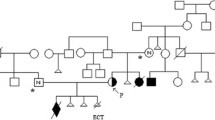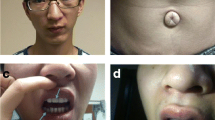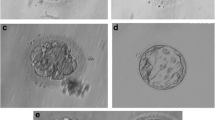Abstract
Here we describe a rare case of anapparently balanced karyotypeof 46, XY, t(1;22;4)(p22.3;q11.1;q31.1) in a infertile male with oligoastenoteratozoospermia (OAT). He was the second patient with complex chromosomal rearrangement (CCR) referred to our center because of infertility. Wealso review reportson 24 males carrying CCRs with spermatogenesis failure or a malformed child, to provide information on the reproductive outcome of male CCR carriers.
Similar content being viewed by others
References
Bartels I, Starke H, Argyriou L, Sauter SM, Zoll B, Liehr T, 2007. An exceptional complex chromosomal rearrangement (CCR) with eight breakpoints involving four chromosomes (1;3;9;14) in an azoospermic male with normal phenotype. Eur J Med Genet 50: 133–138.
Borg K, Stankiewicz P, Bocian E, Kruczek A, Obersztyn E, Lupski JR, Mazurczak T, 2005. Molecular analysis of a constitutional complex genome rearrangement with 11 breakpoints involving chromosomes 3, 11, 12, and 21 and a approximately 0.5-Mb submicroscopic deletion in a patient with mild mental retardation. Hum Genet 118: 267–75.
Bourrouillou G, Rolland Mand Colombies P, 1983. Secondary 18q2 dueto a paternal double translocation. J Genet Hum 31: 243–249.
Cai T, YuP, Tagle DA, Lu D, Chen Y, Xia J, 2001. A de novo complex chromosomal rearrangement with a translocation 7;9 and 8q insertion in a male carrier with no infertility. Hum Reprod 16: 59–62.
Chandley AC, Edmond P, Christie S, Gowans L, Fletcher J, Frackiewicz A and Newton M, 1975. Cytogenetics and infertility in man. I. Karyotype and seminal analysis: results of a five-year survey of men attending a subfertility clinic. Ann Hum Genet 39: 231–254.
Coco R, Rahn MI, Estanga PG, Antonioli G, Solari AJ, 2004. A constitutional complex chromosome rearrangement involving meiotic arrest in an azoospermic male: case report. Hum Reprod 19: 2784–2790.
Escudero T, Estop A, Fischer J, Munne S, 2008. Preimplantation genetic diagnosis for complex chromosome rearrangements. Am J Med Genet A: 1662–1669.
Gardner M, Sutherland GR. Chromosome Abnormalities and genetic counseling, 2004. 3th ed, Oxford university press.
Gorski JL, Klistenmacher ML, Punnet HH, Zackai EH, Emanuel BS, 1988. Reproductive risk for carriers of complex chromosome rearrangements: analysis of 25 families. Am J Med Genet 29: 247–261.
Grasshoff U, Singer S, Liehr T, Starke H, Fode B, Schöning M, Dufke A, 2003. A complex chromosomal rearrangement with a translocation 4;10;14 in a fertile male carrier: ascertainment through an offspring with partial trisomy 14q13—>q24.1 and partial monosomy 4q27—>q28. Cytogenet Genome Res 103: 17–23.
Johannisson R, Lohrs U, Passarge E, 1988. Pachytene analysis in males heterozygous for a familial translocation (9;12;13)(q22;q22;q32) ascertained through a child with partial trisomy 9. Cytogenet Cell Genet 47: 160–166.
Joly-Helas G, de La Rochebrochard C, Mousset-Siméon N, Moirot H, Tiercin C, Romana SP, et al. 2007. Complex chromosomal rearrangement and intracytoplasmic sperm injection: a case report. Hum Reprod 22: 1292–1297.
Joseph A, Thomas IM, 1982. A complex rearrangement involving three autosomes in a phenotypically normal male presenting with sterility. J Med Genet 19: 375–377.
Karmous-Benailly H, Giuliano F, Massol C, Bloch C, De Ricaud D, Lambert JC, Perelman S, 2006. Unbalanced inherited complex chromosome rearrangement involving chromosome 8, 10, 11and16in apatient with congenital malformations and delayed development. Eur J Med Genet 49: 431–438.
Lee IW, Su MT, Hsu CC, Lin YH, Chen PY, Kuo PL, 2006. Constitutional complex chromosomal rearrangements in azoospermic men: case report and literature review. Urology 68: 1343. e5–8.
Lim CK, Cho JW, Kim JY, Kang IS, Shim SH, Jun JH, 2007. A healthy live birth after successful preimplantation genetic diagnosis for carriers of complex chromosome rearrangements. Fertil Steril. Dec 10. [Epub ahead of print]
Madan K, Nieuwint AWM, van Bever Y, 1997. Recombination in a balanced complex translocation of a mother leading to abalanced reciprocal translocation in the child. Review of 60 cases of balanced complex translocation. Hum Genet 99: 806–15.
Rodriguez MT, Martin MJ, Abrisqueta JA, 1985. A complex balanced rearrangement involving four chromosomes in an azoospermic man. J Med Genet 22: 66–67.
Rosenberg C, Knijnenburg J, Chauffaille Mde L, Brunoni D, Catelani AL, Sloos W, 2005. Array CGH detection of a cryptic deletion in a complex chromosome rearrangement. Hum Genet 116: 390–394.
Rothlisberger B, Kotzot D, Brecevic L, Koehler M, Balmer D, Binkert F, Schinzel A, 1999. Recombinant balanced and unbalanced translocations as a consequence of a balanced complex chromosomal rearrangement involving eight breakpoints in four chromosomes. Eur J Hum Genet 7: 873–883.
Saadallah N, Hulten M, 1985. A complex three break-point translocation involving chromosomes 2, 4, and 9 identified by meiotic investigations of a human male ascertained for subfertility. Hum Genet 71: 312–320.
Salahshourifar I, Gilani MA, Vosough A, Tavakolzadeh T, Tahsili M, Mansori Z, 2007. De novo complex chromosomal rearrangement of 46, XY, t(3; 16;8)(p26; q13;q21.2)inanon-obstructive azoospermic male. J Appl Genet 48: 93–4.
Schmidt A, Passarge E, 1988. A complex familial translocation with a five-break rearrangement involving three chromosomes. Clin Genet 34: 415.
Schwanitz G, Schmid P, Berthold HJ, Grosse KP, 1978. Partial trisomy 13 with clinical signs of Patau syndrome resulting from a complex paternal rearrangement of chromosomes 6, 10 and 13. Ann Genet 21: 100–103.
Siffroi JP, Benzacken B, Straub B, Le Bourhis C, North MO, Curotti G, 1997. Assisted reproductive technology and complex chromosomal rearrangements: the limits of ICSI. Mol Hum Reprod 3: 847–51.
Sills ES, Kim JJ, Witt MA, Palermo GD, 2005. Non-obstructive azoospermia and maturation arrest with complex translocation 46, XY t(9;13;14) (p22;q21.2;p13) is consistent with the Luciani-Guo hypothesis of latent aberrant autosomal regions and infertility. Cell Chromosome 4: 2.
Walker S, Howard PJ, Hunter D, 1985. Familial complex autosomal translocations involving chromosomes 7, 8 and 9 exhibiting male and female transmission with segregation and recombination. J Med Genet 22: 484–491.
Author information
Authors and Affiliations
Corresponding author
Rights and permissions
About this article
Cite this article
Salahshourifar, I., Shahrokhshahi, N., Tavakolzadeh, T. et al. Complex chromosomal rearrangement involving chromosomes 1, 4 and 22 in an infertile male: case report and literature review. J Appl Genet 50, 69–72 (2009). https://doi.org/10.1007/BF03195655
Received:
Accepted:
Issue Date:
DOI: https://doi.org/10.1007/BF03195655




